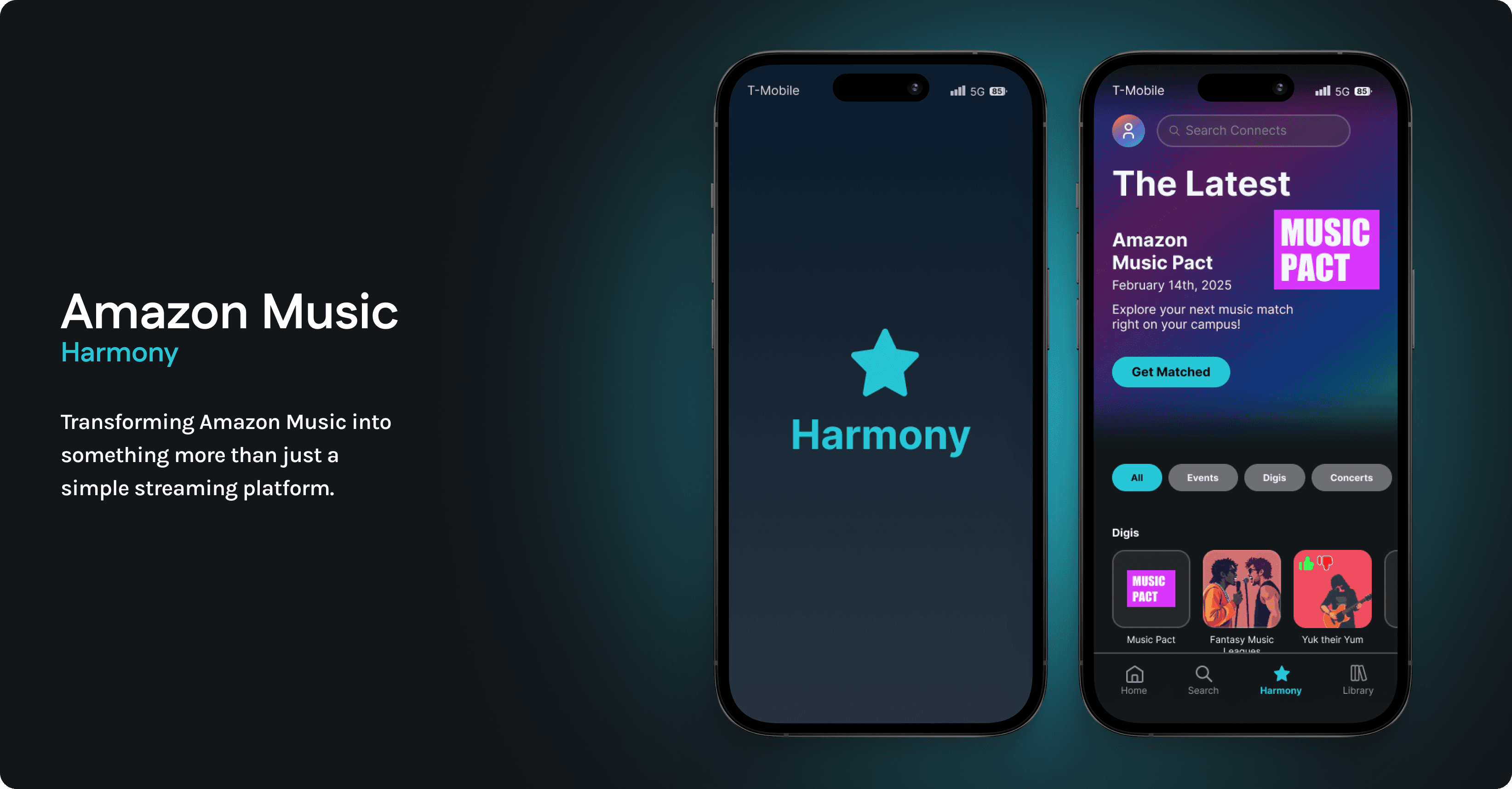
CONTEXT
During Winter 2024, I was given the opportunity to work with Amazon Music through a design practicum in the San Francisco Bay Area through a Northwestern Medill & SEGAL sponsored program called the "Bay Area Immersion Program." Through this program, us students were given the opportunity to work with real project partners such as Amazon Music to deliver an entirely new and wholistic product with the possibility of being launched.
ROLE
Product Designer
TIMELINE
January 2025 - March 2025
TEAM
1 Project Partner
4 Product Designers
TOOLS
Figma
Marvel Pop
My Contributions
My Contributions
My Contributions
User Research
Conducted user research through 20+ user interviews and 5+ usability tests to finalize our concept.
Conducted user research through 20+ user interviews and 5+ usability tests to finalize our concept.
Iterative Design
Balanced stakeholder requirements, technical constraints, and user needs through iterative design.
Balanced stakeholder requirements, technical constraints, and user needs through iterative design.
Building & Designing
Responsible for the user interface design and turning research insights into tangible design items.
Responsible for the user interface design and turning research insights into tangible design items.
MUSIC IS CONNECTION
MUSIC IS CONNECTION
One song shared can enrich both a bond and oneself.
One song shared can enrich both a bond and oneself.
One song shared can enrich both a bond and oneself.
Sharing music strengthens bonds and shapes a personal identity. A song carries memories, emotions, and pieces of ourselves. When shared, it creates space for joy, vulnerability, and recognition. Whether it’s showing off favorite tracks or singing along to nostalgic anthems, music unites us with others while reconnecting us with who we are.
Sharing music strengthens bonds and shapes a personal identity. A song carries memories, emotions, and pieces of ourselves. When shared, it creates space for joy, vulnerability, and recognition. Whether it’s showing off favorite tracks or singing along to nostalgic anthems, music unites us with others while reconnecting us with who we are.
PROBLEM DISCOVERY
PROBLEM DISCOVERY
Gen Z music listeners love to share what they’re listening.
Gen Z music listeners love to share what they’re listening.
Gen Z music listeners love to share what they’re listening.
In early conversations and interviews with Northwestern students about their music listening habits, many emphasized that sharing music is a central part of the experience. From posting their Spotify Wrapped to highlighting favorite tracks on Instagram, sharing music allows them to express identity and connect with others.
Some ways Gen Z shares music include:
In early conversations and interviews with Northwestern students about their music listening habits, many emphasized that sharing music is a central part of the experience. From posting their Spotify Wrapped to highlighting favorite tracks on Instagram, sharing music allows them to express identity and connect with others.
Some ways Gen Z shares music include:



THE PROBLEM
THE PROBLEM
HMW evolve Amazon Music into a vibrant platform where fans can connect beyond just streaming?
HMW evolve Amazon Music into a vibrant platform where fans can connect beyond just streaming?
HMW evolve Amazon Music into a vibrant platform where fans can connect beyond just streaming?
COMPETITIVE ANALYSIS
COMPETITIVE ANALYSIS
The audio streaming market is saturated with platforms offering similar core features.
The audio streaming market is saturated with platforms offering similar core features.
The audio streaming market is saturated with platforms offering similar core features.
Spotify leads with rich social features like Jams, Blends, shared playlists, and friend activity.
Apple Music offers limited social tools, mainly viewing friend activity in the “For You” tab.
YouTube Music, SoundCloud, Pandora, and others offer basic, standard streaming features.
So how can we create something that is “uniquely Amazon?”
Spotify leads with rich social features like Jams, Blends, shared playlists, and friend activity.
Apple Music offers limited social tools, mainly viewing friend activity in the “For You” tab.
YouTube Music, SoundCloud, Pandora, and others offer basic, standard streaming features.
So how can we create something that is “uniquely Amazon?”



COMPETITIVE DIFFERENTIATION
COMPETITIVE DIFFERENTIATION
Amazon Music can stand out by enhancing the music sharing experience.
Amazon Music can stand out by enhancing the music sharing experience.
Amazon Music can stand out by enhancing the music sharing experience.
With so much "noise" in a crowded market of streaming platforms offering nearly identical features, Amazon Music has the opportunity to truly experiment and push boundaries. Instead of focusing only on enhancing the listening experience through Ultra HD music, Amazon Music can stand out by reimagining how effortlessly users share songs across platforms and with peers.
With so much "noise" in a crowded market of streaming platforms offering nearly identical features, Amazon Music has the opportunity to truly experiment and push boundaries. Instead of focusing only on enhancing the listening experience through Ultra HD music, Amazon Music can stand out by reimagining how effortlessly users share songs across platforms and with peers.
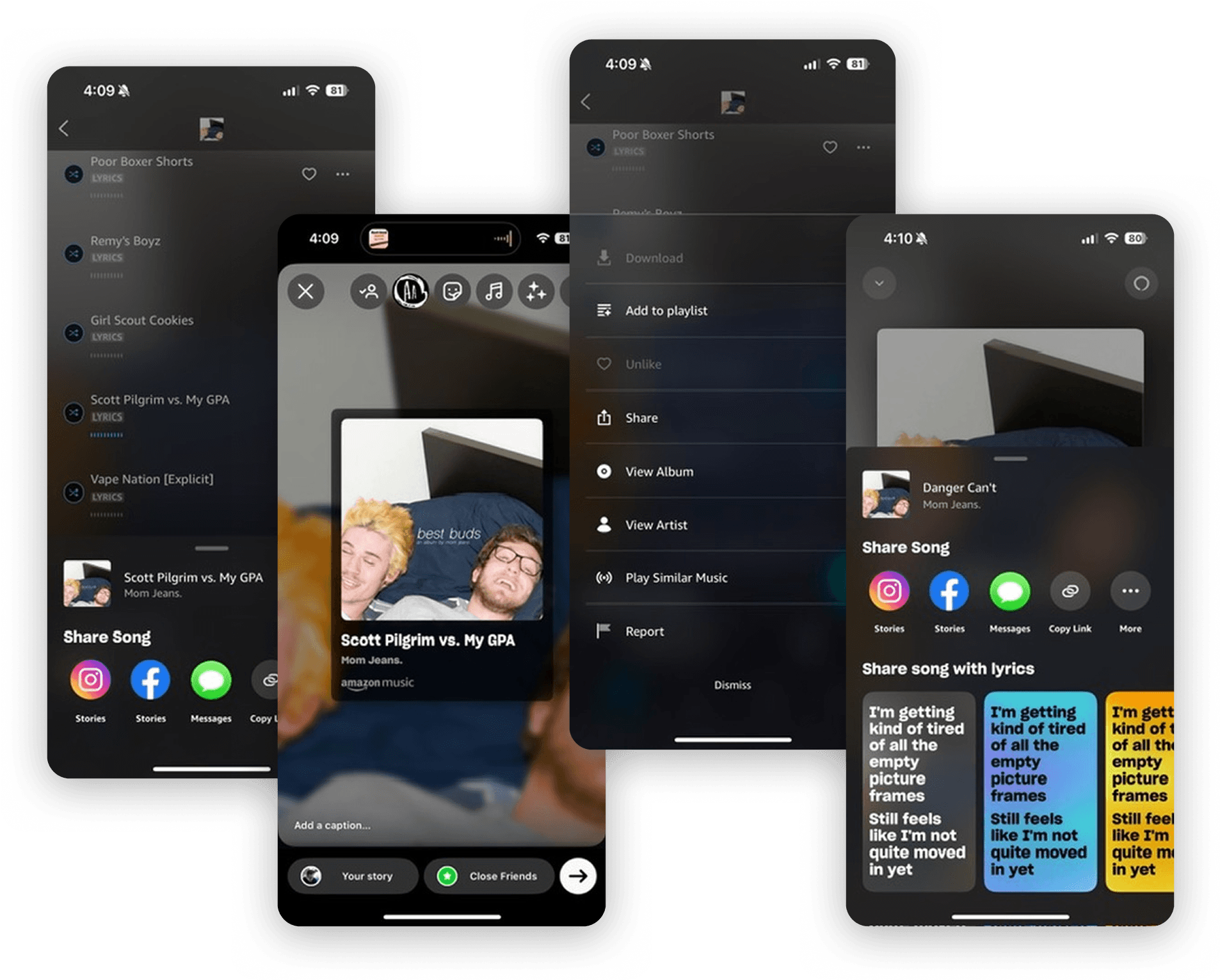


RESEARCH VALIDATION
RESEARCH VALIDATION
Interviewing 20+ Gen Z music listeners revealed that users crave social listening and sharing experiences
Interviewing 20+ Gen Z music listeners revealed that users crave social listening and sharing experiences
Interviewing 20+ Gen Z music listeners revealed that users crave social listening and sharing experiences
We as a team conducted semi-structured interviews with current Spotify, Apple Music, YouTube Music, and Amazon Music listeners to validate our initial findings, understand different methods of music sharing experiences, and gather the emotional ties that music sharing as on users.
We as a team conducted semi-structured interviews with current Spotify, Apple Music, YouTube Music, and Amazon Music listeners to validate our initial findings, understand different methods of music sharing experiences, and gather the emotional ties that music sharing as on users.
UNDERSTANDING KEY INSIGHTS
UNDERSTANDING KEY INSIGHTS
Sharing music is more than an experience. It reflects identity and carries emotional value.
Sharing music is more than an experience. It reflects identity and carries emotional value.
Sharing music is more than an experience. It reflects identity and carries emotional value.
From our interview notes, we found that sharing music has a deeper impact than expected. It is closely tied to personal identity and can bridge connections between people, strengthening existing bonds or creating new ones. Beyond posting songs on social media, sharing also happens through concerts or even simple conversations about music.
From our interview notes, we found that sharing music has a deeper impact than expected. It is closely tied to personal identity and can bridge connections between people, strengthening existing bonds or creating new ones. Beyond posting songs on social media, sharing also happens through concerts or even simple conversations about music.
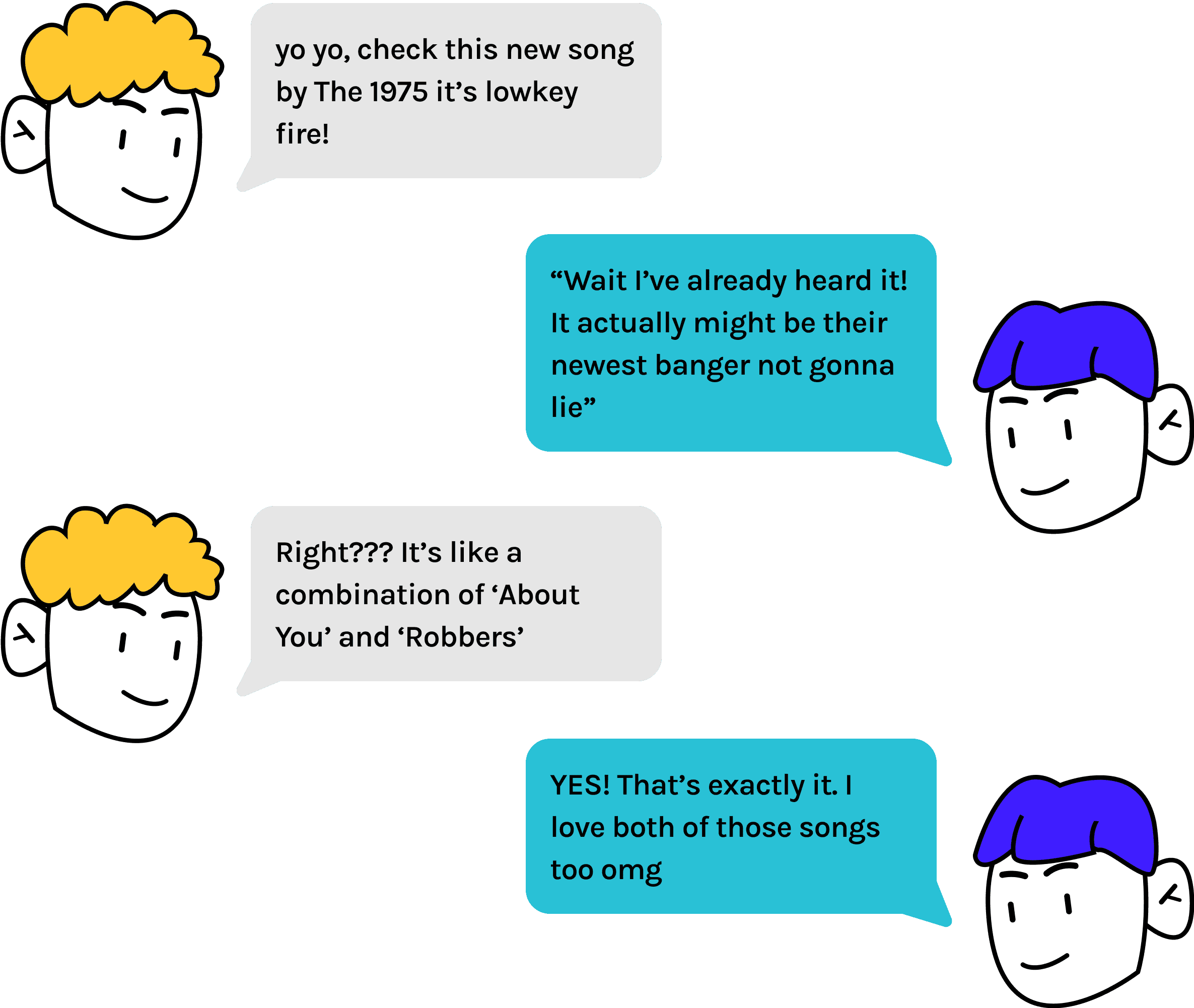


WHO ARE WE DESIGNING FOR?
WHO ARE WE DESIGNING FOR?
Creating user personas to guide and ground ideation.
Creating user personas to guide and ground ideation.
Creating user personas to guide and ground ideation.
From our research, we developed three distinct personas. These serve as key references to our user groups, guiding brainstorming and ensuring that our designs remain user-centered.
From our research, we developed three distinct personas. These serve as key references to our user groups, guiding brainstorming and ensuring that our designs remain user-centered.









Considering brand loyalty when defining user groups.
Considering brand loyalty when defining user groups.
Considering brand loyalty when defining user groups.
Although the Quiet Quincy persona appeared in our research, we concluded that users deeply committed to a specific brand are unlikely to switch platforms. As a result, we chose to focus on Social Sally and Lurking Louise, exploring how their behaviors and experiences could be better supported on Amazon Music.
Although the Quiet Quincy persona appeared in our research, we concluded that users deeply committed to a specific brand are unlikely to switch platforms. As a result, we chose to focus on Social Sally and Lurking Louise, exploring how their behaviors and experiences could be better supported on Amazon Music.
BRAINSTORMING & IDEATION
BRAINSTORMING & IDEATION
Brainstorming and ideating with our main personas in mind.
Brainstorming and ideating with our main personas in mind.
Brainstorming and ideating with our main personas in mind.
With a clearer understanding of how and why people share music, our team began brainstorming solutions tailored to our target audience and personas. We organized insights through affinity diagramming and held open whiteboarding sessions to generate a wide range of ideas and bring our early concepts to life.
With a clearer understanding of how and why people share music, our team began brainstorming solutions tailored to our target audience and personas. We organized insights through affinity diagramming and held open whiteboarding sessions to generate a wide range of ideas and bring our early concepts to life.
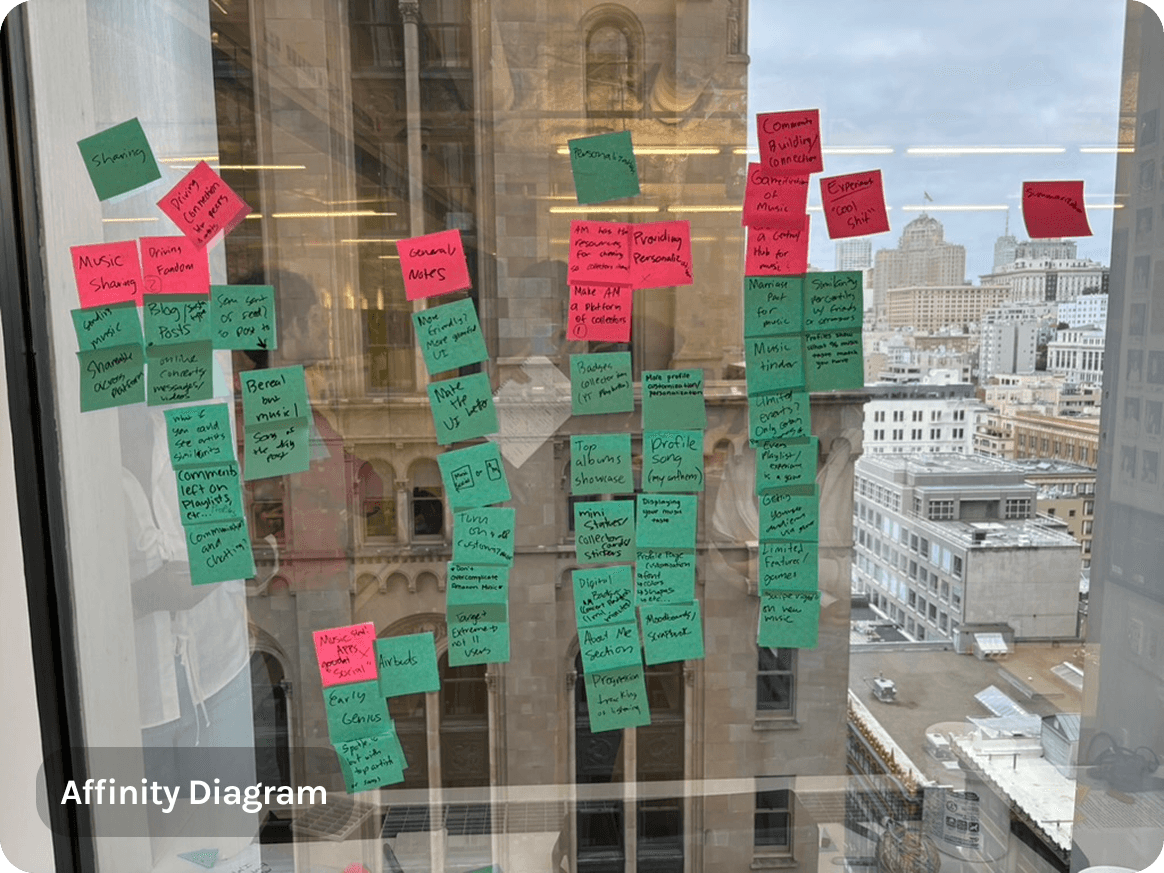


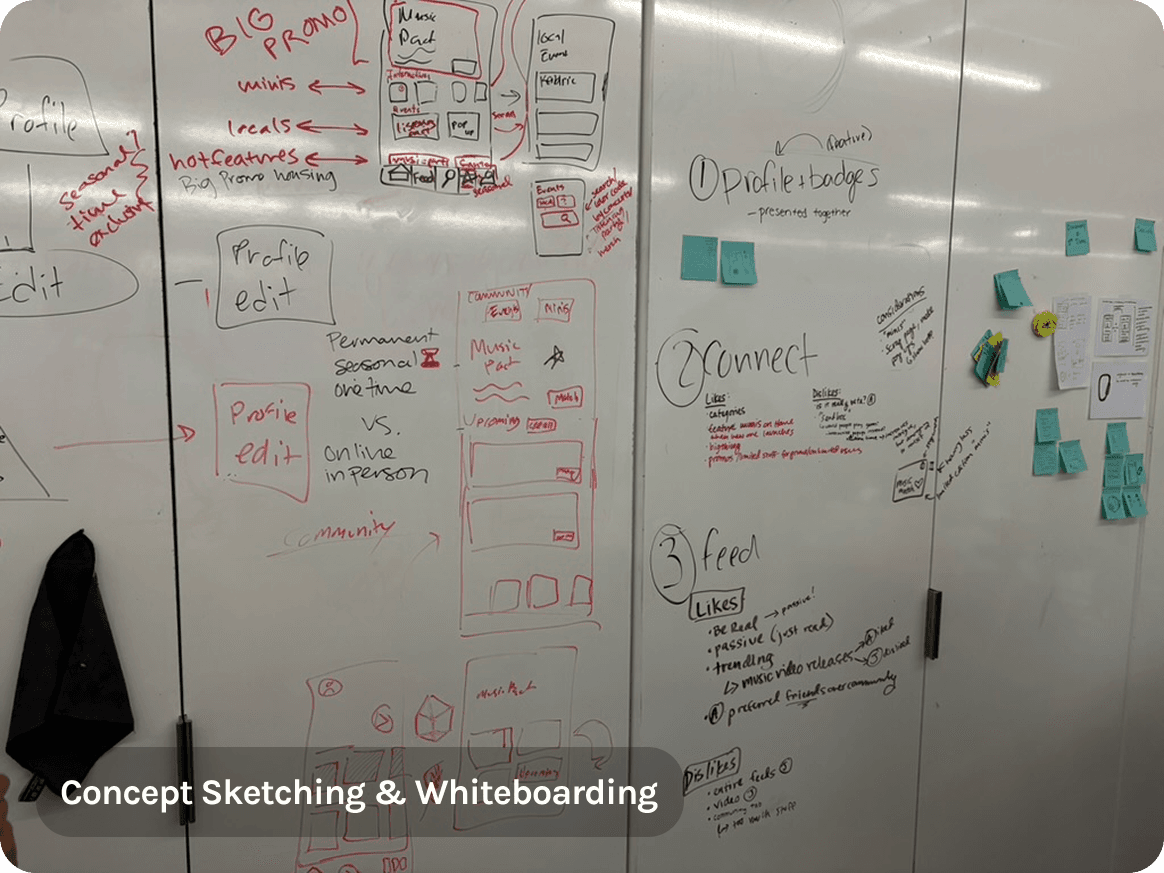


A FOCUSED SOLUTION
A FOCUSED SOLUTION
Emphasizing community engagement and social interaction
Emphasizing community engagement and social interaction
Emphasizing community engagement and social interaction
Leveraging insights from user interviews, we narrowed our solutions into a single page called Harmony, designed to host features that help users connect and build bonds with both new and familiar connections.
Key features include:
Leveraging insights from user interviews, we narrowed our solutions into a single page called Harmony, designed to host features that help users connect and build bonds with both new and familiar connections.
Key features include:
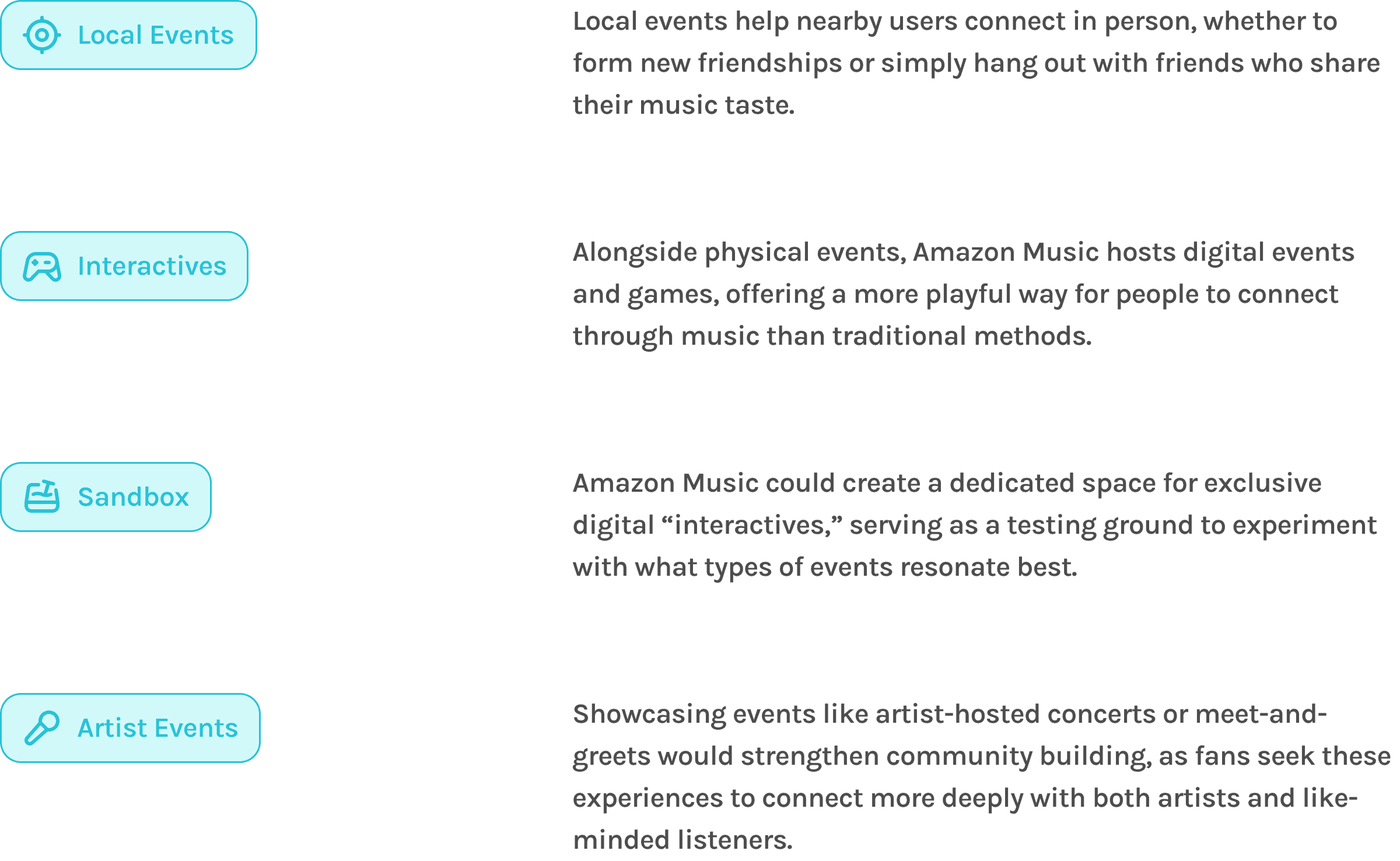


WIREFRAMING & LOW-FIDELITIES
WIREFRAMING & LOW-FIDELITIES
Wireframes reflecting the requirements of different users.
Wireframes reflecting the requirements of different users.
Wireframes reflecting the requirements of different users.
After extensive research and ideation, our team began creating the initial mockups to present to project stakeholders. These included basic grayscale wireframes and team-generated sketches.
After extensive research and ideation, our team began creating the initial mockups to present to project stakeholders. These included basic grayscale wireframes and team-generated sketches.
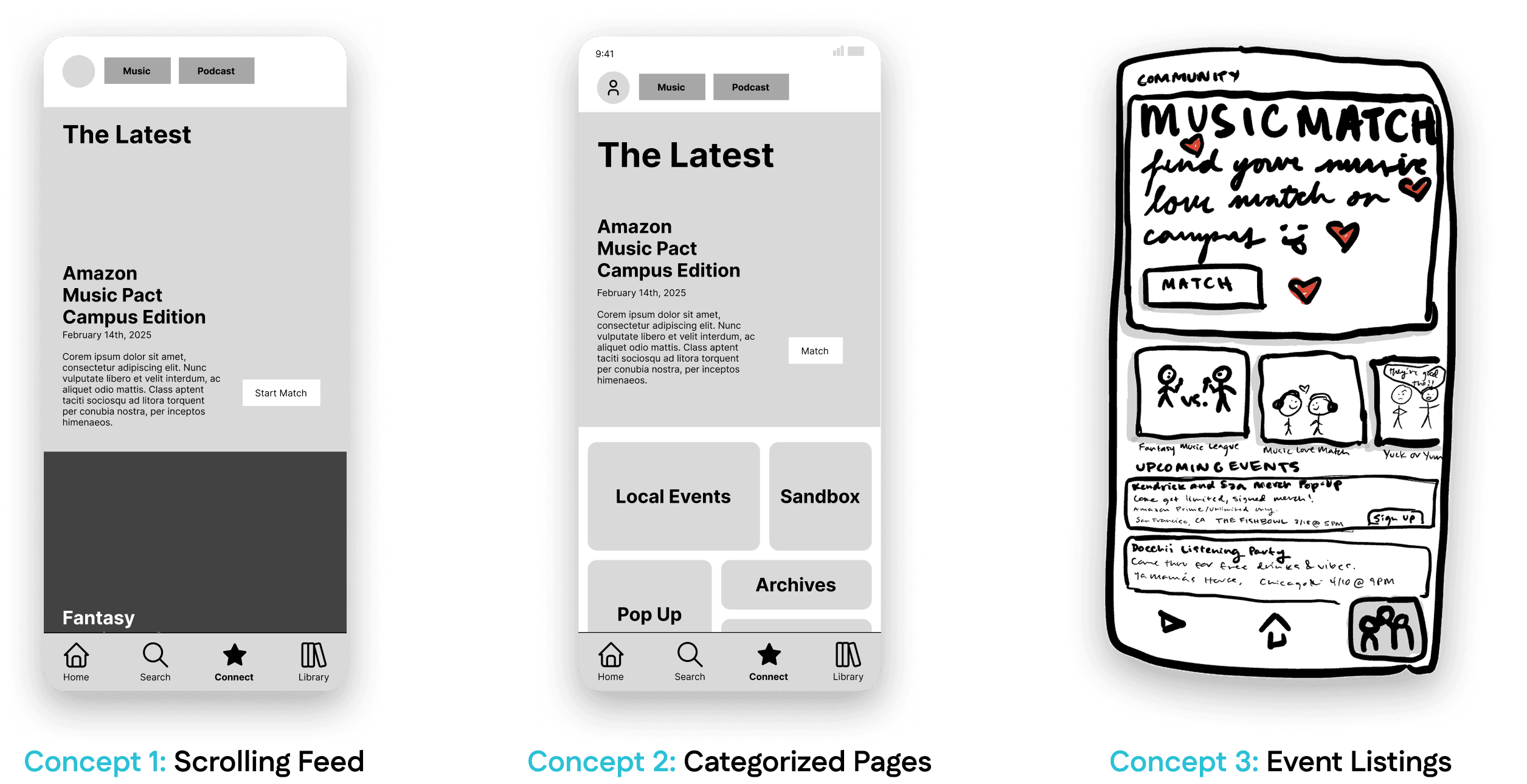


MID QUARTER SHAREOUTS
MID QUARTER SHAREOUTS
Pivot following discussions with Amazon Music’s product manager.
Pivot following discussions with Amazon Music’s product manager.
Pivot following discussions with Amazon Music’s product manager.
After presenting our initial concepts to the stakeholder, we noticed potential confusion and disorganization in some features. This led us to revise our designs, creating a clearer categorization to better address both user and stakeholder needs.
After presenting our initial concepts to the stakeholder, we noticed potential confusion and disorganization in some features. This led us to revise our designs, creating a clearer categorization to better address both user and stakeholder needs.
Pivot to simpler categorization.
Pivot to simpler categorization.
Pivot to simpler categorization.
We realized some solution features were overlapping, both aiming to create exclusive, trend-driven experiences like Spotify Wrapped. Sandbox and Interactives were intended to spark these interactions, but separating them added complexity. We merged them into a single feature, Time Sensitive Events, simplifying the user flow while maintaining excitement and engagement.
We realized some solution features were overlapping, both aiming to create exclusive, trend-driven experiences like Spotify Wrapped. Sandbox and Interactives were intended to spark these interactions, but separating them added complexity. We merged them into a single feature, Time Sensitive Events, simplifying the user flow while maintaining excitement and engagement.



ITERATED SOLUTION
ITERATED SOLUTION
Simplifying event categorization.
Simplifying event categorization.
Simplifying event categorization.
With the updated event categories, we further simplified our solution by organizing events by type. Digital events are labeled as Time Sensitive, while location-based or physical events are categorized as Physical.
The new solution includes the following features:
With the updated event categories, we further simplified our solution by organizing events by type. Digital events are labeled as Time Sensitive, while location-based or physical events are categorized as Physical.
The new solution includes the following features:



FINAL DESIGN
FINAL DESIGN
An experience far beyond just streaming.
An experience far beyond just streaming.
An experience far beyond just streaming.
Through an iterative design process and continuous revisions, we finalized our design and had the opportunity to present our findings and deliverables to a team of developers and designers at Amazon Music.
Through an iterative design process and continuous revisions, we finalized our design and had the opportunity to present our findings and deliverables to a team of developers and designers at Amazon Music.
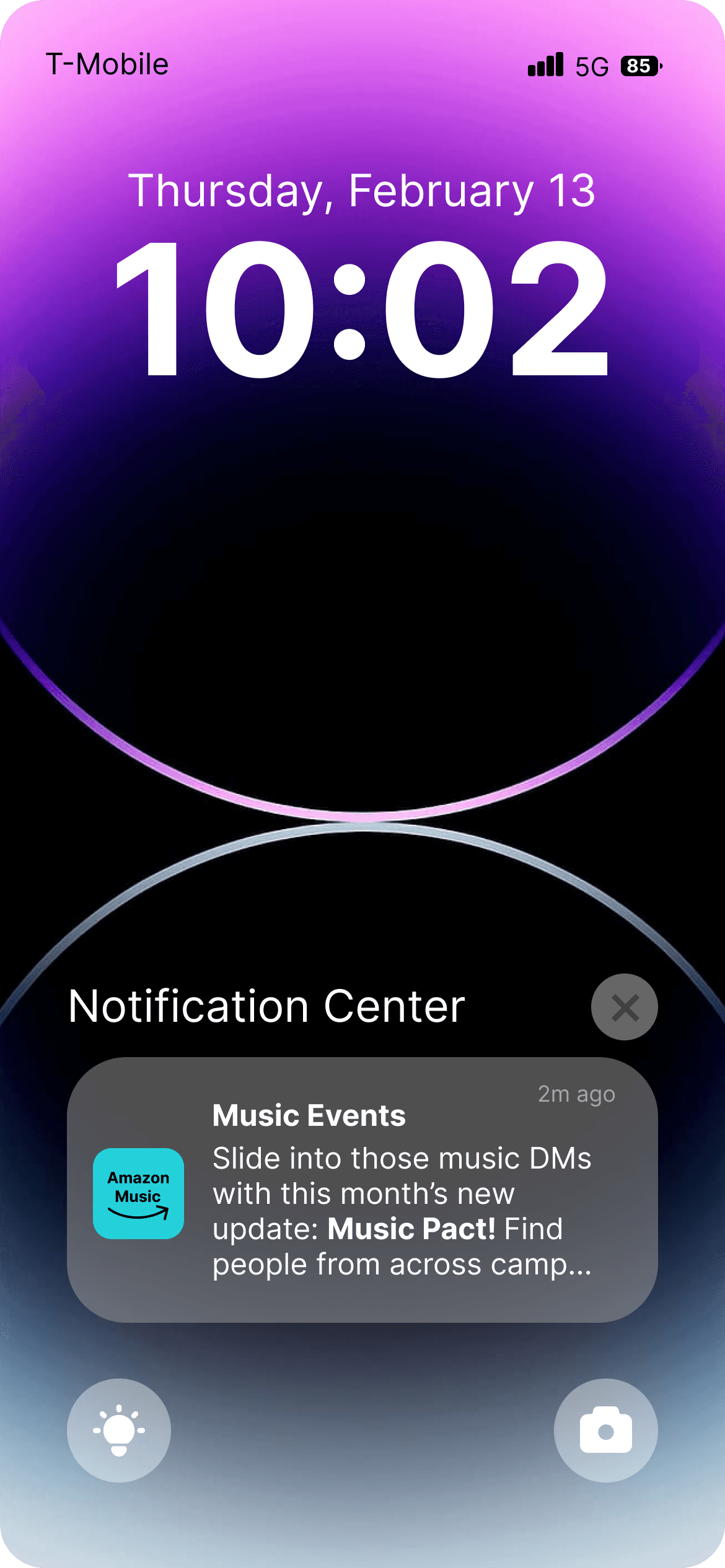


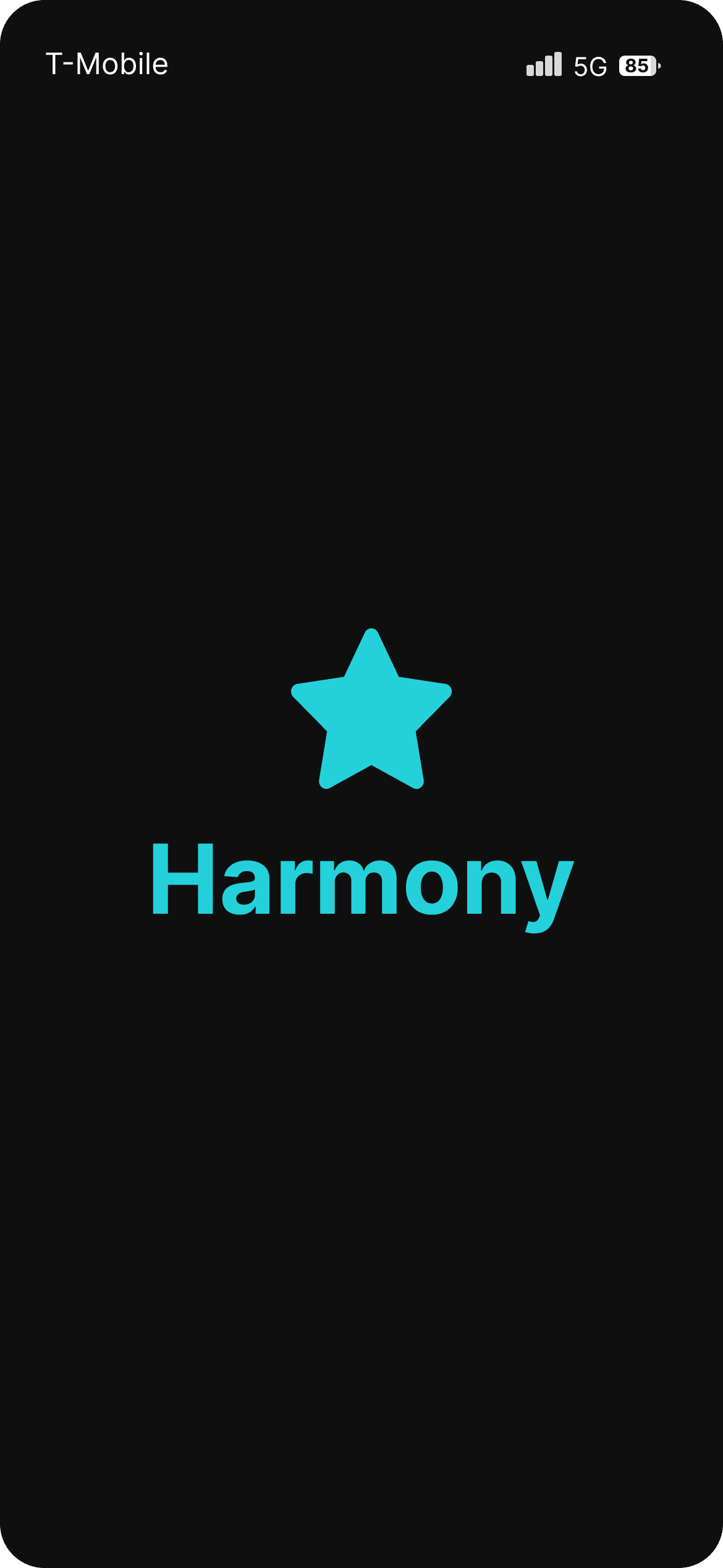


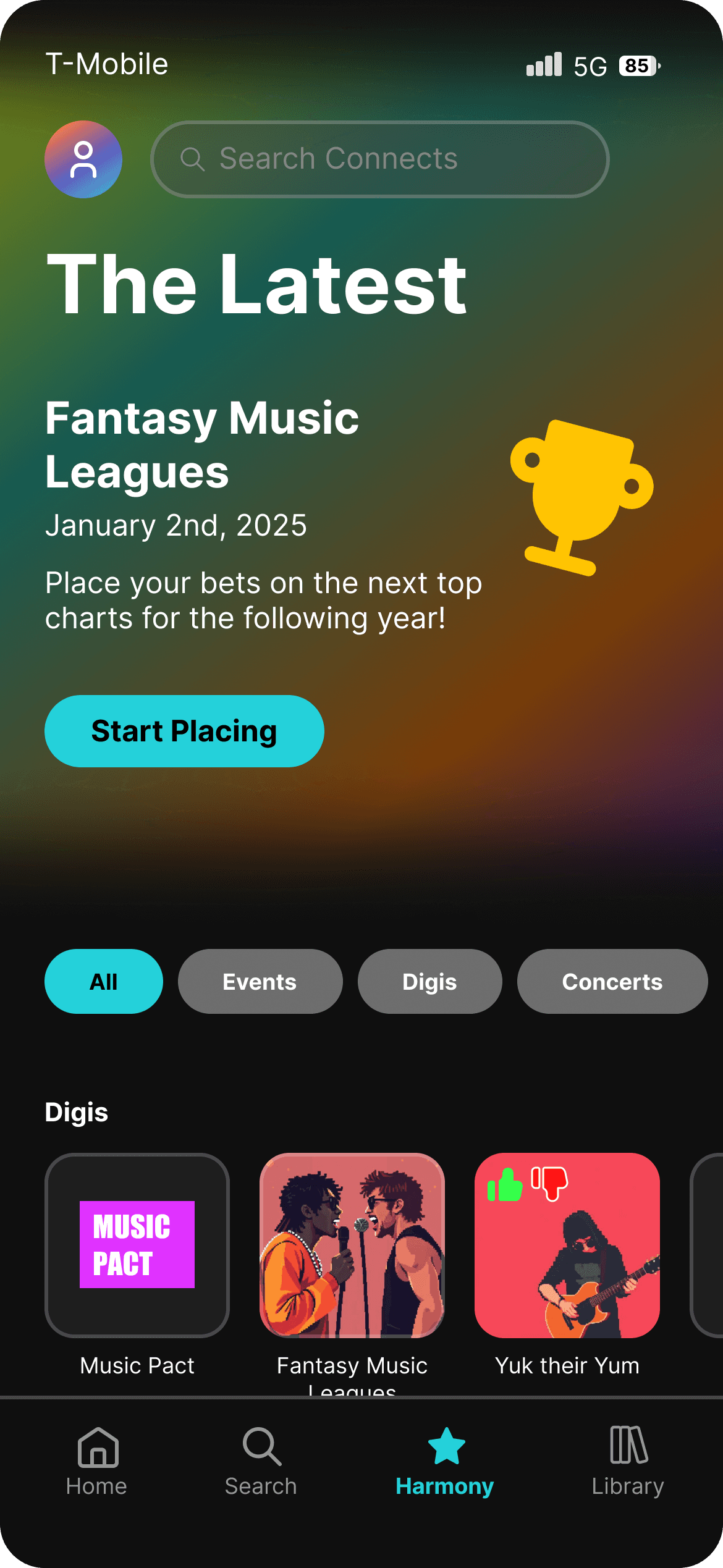


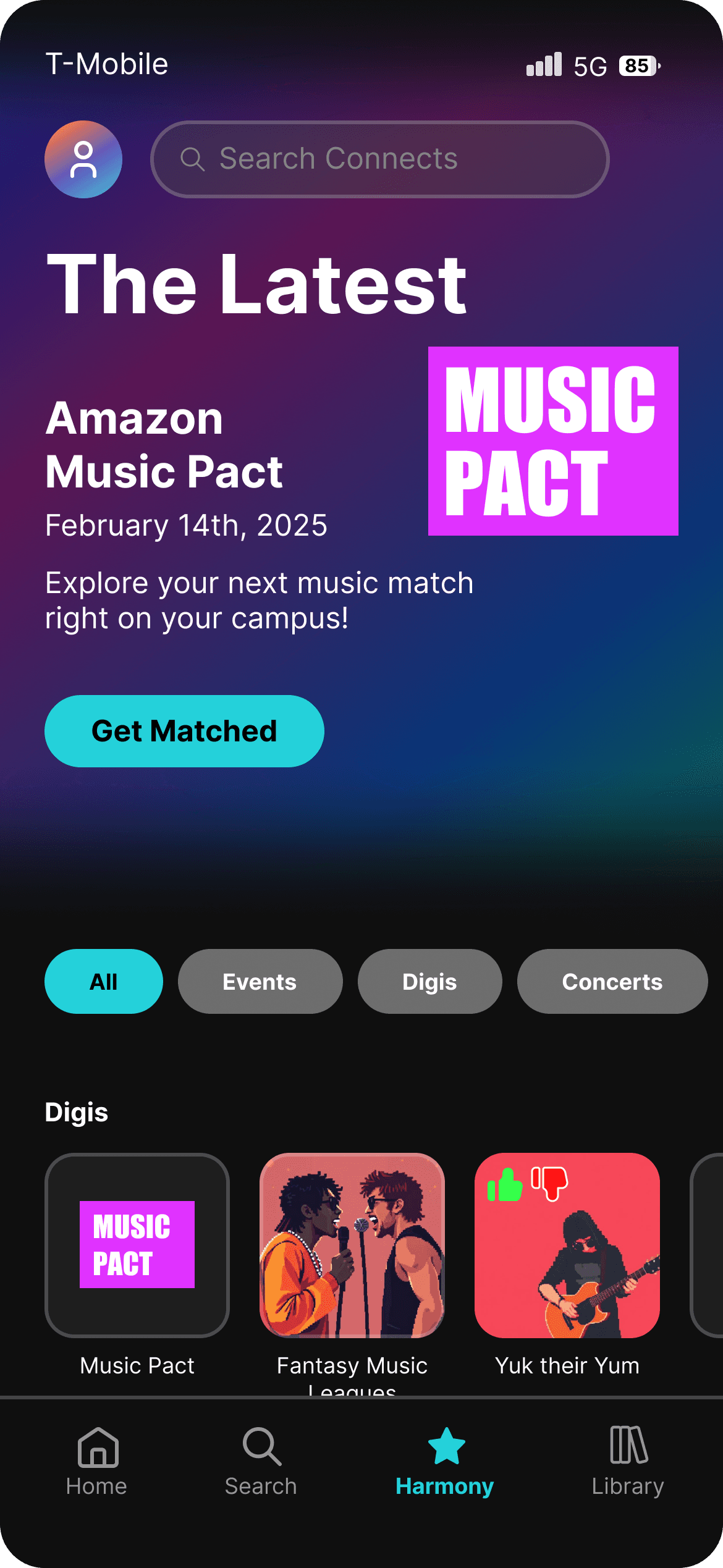


Showcasing our work from the past quarter.
Showcasing our work from the past quarter.
Showcasing our work from the past quarter.
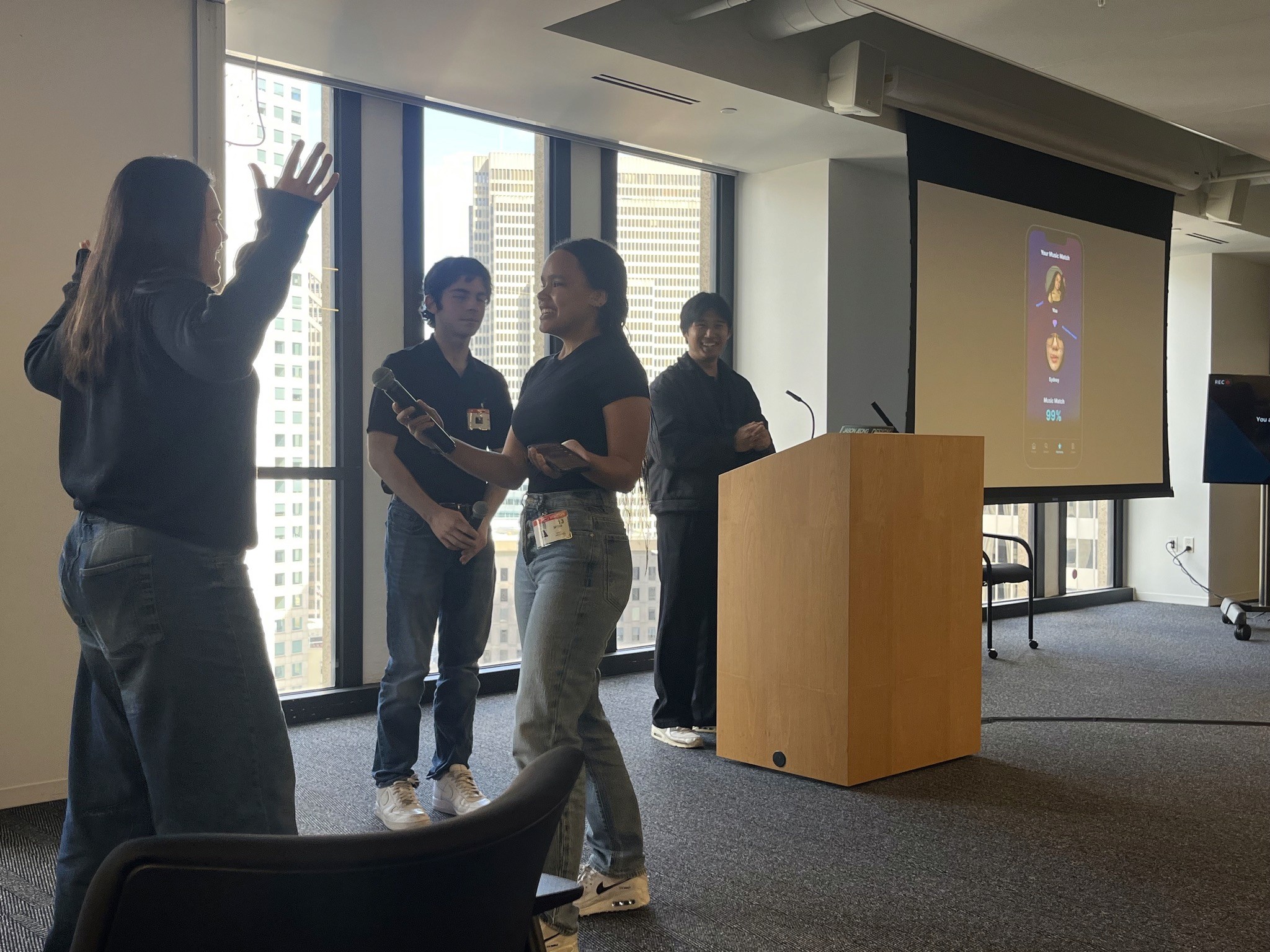


MAJOR TAKEAWAYS & LEARNINGS
MAJOR TAKEAWAYS & LEARNINGS
Strong communication skills benefit both team collaboration and stakeholder engagement.
Strong communication skills benefit both team collaboration and stakeholder engagement.
Strong communication skills benefit both team collaboration and stakeholder engagement.
Understanding Individual Skillsets
Understanding Individual Skillsets
Throughout this project, I worked with teammates from diverse backgrounds, including journalism, computer science, and design like myself. Recognizing these unique skillsets and fostering an effective team environment enabled highly productive brainstorming sessions that allowed each of us to showcase our strengths.
Throughout this project, I worked with teammates from diverse backgrounds, including journalism, computer science, and design like myself. Recognizing these unique skillsets and fostering an effective team environment enabled highly productive brainstorming sessions that allowed each of us to showcase our strengths.
Proper Storytelling and Communication is Key
Proper Storytelling and Communication is Key
This project involved frequent presentations and communication with key stakeholders. It required us not only to clearly articulate our ideas but also to engage the audience through compelling storytelling of our ideas.
This project involved frequent presentations and communication with key stakeholders. It required us not only to clearly articulate our ideas but also to engage the audience through compelling storytelling of our ideas.